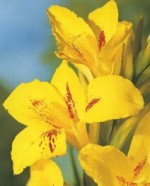 Most bulbs like well-drained soil and will rot if they don’t get it. But there are some bulbs that actually like or at least tolerate damp soil. Grow them with other plants that like moist conditions such as Elephant Ear, Japanese iris, Ligularia ‘The Rocket’, astilibes, or Lobelia (Cardinal flower). Some bulbs like shade too and make good plants for woodland settings.
Most bulbs like well-drained soil and will rot if they don’t get it. But there are some bulbs that actually like or at least tolerate damp soil. Grow them with other plants that like moist conditions such as Elephant Ear, Japanese iris, Ligularia ‘The Rocket’, astilibes, or Lobelia (Cardinal flower). Some bulbs like shade too and make good plants for woodland settings.
Here are five bulbs for damp conditions.
 Camassia sp.
Camassia sp.
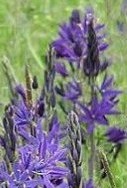 Also called quamash or wild hyacinth, this edible bulb is native to the U.S. northwest. The star shaped flowers are born on upright stems and open from the bottom up after the main bulbs bloom in spring and before the summer perennials do their thing.
Also called quamash or wild hyacinth, this edible bulb is native to the U.S. northwest. The star shaped flowers are born on upright stems and open from the bottom up after the main bulbs bloom in spring and before the summer perennials do their thing.
-
Hardiness: USDA Zones 4-8
Bloom Time: Late spring, early summer.
Flower Color: blue, white
Foliage: Upright, long narrow, green.
Height: 2-3’
Light: Full sun to partial shade
 Canna sp.
Canna sp.
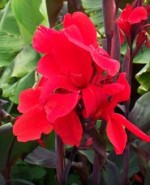 The very Victorian looking cannas give a lush tropical look to the garden and some cultivars can be grown in water as well as soil. Many have beautiful foliage as well as bright colors and their slender upright stature lends an architectural quality to the setting. In most areas the tubers will have to be lifted and stored for the winter.
The very Victorian looking cannas give a lush tropical look to the garden and some cultivars can be grown in water as well as soil. Many have beautiful foliage as well as bright colors and their slender upright stature lends an architectural quality to the setting. In most areas the tubers will have to be lifted and stored for the winter.
-
Hardiness: USDA Zones 7-10
Bloom Time: summer
Flower Color: white, pink, orange, red
Foliage: coarse, large leaves in deep red, yellow variegated, white blotched, multicolored, and green depending on the cultivar.
Height: 2 to 14″ depending on the cultivar.
Light: Full sun
 Guinea Hen Flower (Fritillaria meleagris)
Guinea Hen Flower (Fritillaria meleagris)
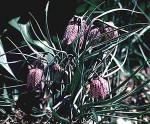 The unique looking flowers of these plants make these bulbs an interesting addition to a damp woodland or meadow area in cool climates. Grown in gardens for over 500 years, it naturalizes well if the environment is to its liking. Plant it with Lenten rose, Helleborus orientalis, for an early spring treat. Good for forcing but has a skunky order. Like all Fritillaria, the bulbs lack a coat and dry out quickly so have to be planted as soon as possible in fall.
The unique looking flowers of these plants make these bulbs an interesting addition to a damp woodland or meadow area in cool climates. Grown in gardens for over 500 years, it naturalizes well if the environment is to its liking. Plant it with Lenten rose, Helleborus orientalis, for an early spring treat. Good for forcing but has a skunky order. Like all Fritillaria, the bulbs lack a coat and dry out quickly so have to be planted as soon as possible in fall.
-
Hardiness: USDA Zones 3-8
Bloom Time: early spring
Flower Color: speckled maroon-purple and white Foliage: linear, grass-like, green leaves.
Height: 9-12”
Light: Full sun to part shade
 Summer snowflakes (Leucojum vernum)
Summer snowflakes (Leucojum vernum)
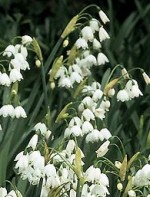 In spite of the name, these snowflakes bloom in spring along with the daffodils and are not to be confused with their cousins, spring snowflakes (Leucojum vernum) that are smaller and bloom earlier.
In spite of the name, these snowflakes bloom in spring along with the daffodils and are not to be confused with their cousins, spring snowflakes (Leucojum vernum) that are smaller and bloom earlier.
-
Hardiness: USDA Zones 4-9
Bloom Time: Mid spring
Flower Color: white tipped with green
Foliage: Strappy, grass-like
Height: 12-15”
Light: light shade
 Turk’s Cap Lily (Lilium superbum)
Turk’s Cap Lily (Lilium superbum)
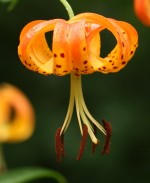 This true lily is a native of the central and eastern areas of North America. Each flower has recurved orange petals with purple-brown spots and prominent stamens with long anthers, giving it the look of a Turks cap, one of its common names. Each stem can bear up to 40 flowers but usually has 1-12.
This true lily is a native of the central and eastern areas of North America. Each flower has recurved orange petals with purple-brown spots and prominent stamens with long anthers, giving it the look of a Turks cap, one of its common names. Each stem can bear up to 40 flowers but usually has 1-12.
-
Hardiness: USDA Zones 5-9
Bloom Time: early to mid summer
Flower Color: varying shades of orange with brownish purple spots.
Foliage: Seven inch long leaves, about 1” wide; stiff and sometimes curved upward along their margins.
Height: 3-7’
Light: Full to partial sun.
If you have a damp area in your garden there is probably a bulb that will flourish in the moisture so give one of these a try. That problem area can become a touch of paradise with these bulbs growing there, especially if you add some moisture loving companions.
